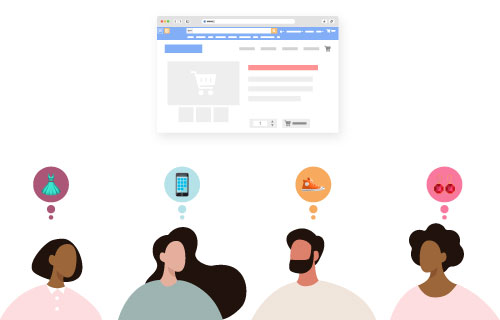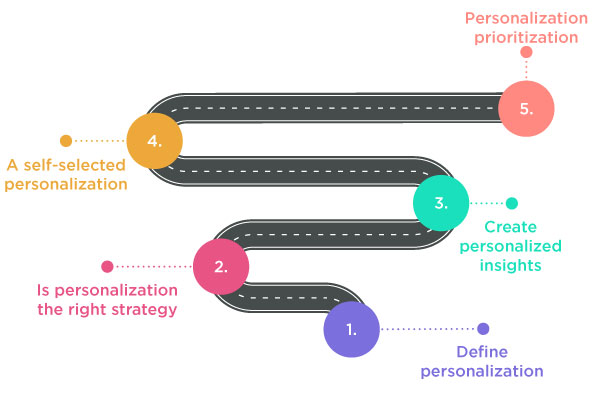A personalization strategy is similar to dismantling our life’s old patterns to take over a breakthrough and arrive at an illuminated path. Like our life, marketing tactics also follow an old pattern, and a marketer has to go through vicious cycles of overpromoting, over-promising, and disappointing the customers.
There have been many marketing trends and strategies that have helped marketers attain better conversion rates- whether it is a medium like social media or a tool such as multivariate testing. You might have gone through all to get optimized conversions.
But what lacks is a strategy that helps you get the best of both worlds. You need a strategy that could touch the customers’ hearts at first glance, and personalization has opened massive doors to such opportunities. Read this log to know about how to build a smart personalization strategy that converts.
Contents
The Rise Of Personalization

Personalization is all about blending the users’ data and technology. You can engage your segmented users with a simple message or customise their needs at a personal level. Both will give you results if you are using personalization in the right way.
In 2018, marketers were relatively unsuccessful and unsatisfied with the strategies they acquired and the results they achieved with them.
As per a study, only 12% of the marketers were satisfied with the personalization strategies and results. While the rest were moderately happy. It calls us to see the loopholes and what to do further to create a smart personalization strategy.
First of all, let us see what the loopholes the marketers faced were:
- The marketers were not aware of what they were trying to solve.
- They would not be able to analyze the data and get the right framework thinking and insights regarding the insights’ implementation.
- They did not test and created a hypothesis of their personalized ideas.
- There were not enough resources to support and sustain the personalized target segments.
You can resolve any of the loopholes if you have the perfect personalized strategy to pick you from rags to riches. Before straightforwardly jumping to the strategy, we must know a brief introduction to personalization.
What Are The Types of Personalization?

There are two types of personalization :
- Implicit: This type of personalization is usually based on visitor behaviour. Suppose a visitor is exploring several products on your website, which means they show their interest. It nudges the marketer to pull users through product recommendations, such as “You may also be interested in.”
- Explicit: The explicit factors are the geographical location and other useful info that you can use to provide a customer-centric experience. These factors more or less, help out in easing out the personalization processes.
What Are The challenges One Faces in The Marketing Strategy?
1. How to get started:
Take a look at the digital goals and review the website objectives in depth.
2. Website review:
Review your website to see who is visiting your website and why they visit it. Create personas and recognize the journey a user takes through your website.
3. Internal resources:
Evaluate the resources you have to undertake a personalized strategy.
4. Budget and ROI:
Setting a budget and assuming the ROIs you want to procure is quite tricky when you initialize the user journey. But you need to establish one before you bring on a personalized strategy to the table.
How to Create a Roadmap for Your Personalization Strategy?

1. Define personalization

Segmentation is an integral part of the personalized strategy—segment users before you provide them with a customized experience. Also, you must have all the required information about the marketing prospect to customize the experience.
Segmentation is the foundation of providing the users with a personalized experience by first knowing what different groups are and how to serve them, while personalization is the ultimate goal to personalize the needs and desires of the customers and serve them accordingly.
Note: Segmentation lies somewhere in the middle of a mass approach and a personalized approach you take to engage customers. Make sure you are creating tailor-made messages to approach customers to be more customer-centric.
2. Is personalization the right strategy
Before you create your personalization strategy, determine whether it works for your organization or not :
- See if you have enough data about the customers. Create a segment of users first before moving on to personalization.
- Evaluate if you have an experimentation team to turn on your personalization approach.
- Take a look at the resources you have to maintain the segments to move messages at a more granular level.
3. Create personalized insights
If you have got the answers to the above questions, it’s time to build a personalization strategy. But one thing might be puzzling you a lot, and that would be how to get ideas for customized messages and look at the following statements:
- Deductive research: Deductive personalization begins when you assume how your customers will react to personalized messages based on existing theories. Feed your ideas into experiments to know whether personalization is working or not.

For example, You are running a charitable organization and knowing the consistency of the donors. Ask the users what type of donor they are to predict their future behaviour based on past behaviour. You can use segmentation for getting personalized insights and also increase the revenue and average donation value.
- Inductive research: A great way to get insights is AB testing, which you might already be practising optimizing your site. You can see that you can create segments through ab testing results. Therefore, it is relatively easy to get inductive personalization from the AB test data.
4. A self-selected personalization
The easiest and most convenient way to create a personalization strategy is to ask prospects to tell about themselves. This way, they can quickly identify themselves and segment themselves. It will help you make the trigger-specific messaging, and then you can further test the best approach for all the segments.
5. Personalization prioritization
Making personalization your priority must be a choice and not an option. Sometimes you can still fail if you have enough resources and advanced tools. Also, it isn’t easy to personalize for all of your audience segments.
To simplify this process, you can create a personalization hypothesis. Determine the quality and quantity of the audiences which you would like to target. Focus on the quantitative audiences, segment them, and engage them with relevant content.
CONCLUSION
Before creating an effective personalization strategy for your business, you must practice what you already know and keep on implementing what assumptions you once implement. Also, look at the bigger picture while doing marketing optimization.
Also Read:
- Everything You Need to Know About Personalized Emails
- 20 Best Personalization Software & Tools [Detailed Comparison]
- Website Personalization Tool: That Increases Conversion Rate
- E-commerce Personalization: 13 Effective Examples To Boost Your Sales
- 29 Statistics Showing The Potential of Personalization

























 Email
Email SMS
SMS Whatsapp
Whatsapp Web Push
Web Push App Push
App Push Popups
Popups Channel A/B Testing
Channel A/B Testing  Control groups Analysis
Control groups Analysis Frequency Capping
Frequency Capping Funnel Analysis
Funnel Analysis Cohort Analysis
Cohort Analysis RFM Analysis
RFM Analysis Signup Forms
Signup Forms Surveys
Surveys NPS
NPS Landing pages personalization
Landing pages personalization  Website A/B Testing
Website A/B Testing  PWA/TWA
PWA/TWA Heatmaps
Heatmaps Session Recording
Session Recording Wix
Wix Shopify
Shopify Magento
Magento Woocommerce
Woocommerce eCommerce D2C
eCommerce D2C  Mutual Funds
Mutual Funds Insurance
Insurance Lending
Lending  Recipes
Recipes  Product Updates
Product Updates App Marketplace
App Marketplace Academy
Academy

